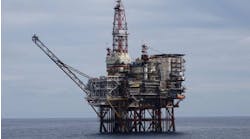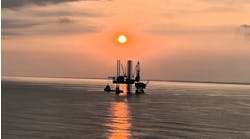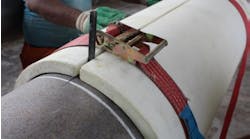Offshore staff
OSLO, Norway – The Norwegian Petroleum Directorate (NPD) has issued a report on E&P activity offshore Norway during the first half of this year.
There were six discoveries over the period, while operators submitted six development plans and three fields started producing.
Fifteen exploration wells were drilled, comprising nine wildcats and six appraisal wells. The six finds that resulted were spread equally between the North Sea, Norwegian Sea, andBarents Sea.
Statoil proved gas near the Valemon field and oil and gas northeast of the Gullfaks field, both in the North Sea.
The company also found oil in a moderate reservoir via a delineation well on the Johan Sverdrup field, whileLundin’s Edvard Grieg delineation well in the same Utsira High region encountered oil in a better-quality reservoir.
In theNorwegian Sea, Statoil found more oil and gas northwest of the Norne field and gas east of the Alve field.
In the Barents Sea, Lundin proved oil and gas in both the 7219/12-1 exploration well and in an appraisal well northwest of the Alta discovery.Statoil found oil in a new prospect 23 km (14.3 mi) southwest of the Johan Castberg discovery well.
During the second half of 2017, Norwegian licensees plan 20-25 exploration wells, NPD said, with potentially eight-10 wells in both the Barents Sea and North Sea, and five wells in the Norwegian Sea.
Three of these wells are already drilling ahead: 7121/8-1 and 7220/11-4 in the Barents Sea and 31/7-2 S in the North Sea.
In the first half of the year, theFlyndre, Sindre, and Gina Krog field developments came onstream.
Maersk Oil developed Flyndre, an oil field in the Ekofisk area, via a subsea well tied in to the Clyde complex across the median line in UK waters, where the majority of the field’s reserves are contained.
Sindre is a small oil field northeast of Gullfaks in the northern Norwegian North Sea, proven via a long well drilled from the Gullfaks C platform which started production in May.
Gina Krog, which started up at the end of June, is an oil and gas field near the Utsira High. Development involved installation of a steel platform and an oil storage ship, with a jackup rig currently drilling the wells.
So far this year NPD has approved plans for development and operation (PDOs) for six fields - Utgard, Byrding, Oda, Dvalin, Trestakk, andBauge - and an amended PDO for Njord in the Norwegian Sea.
Last week Statoil submitted a PDO supplement forSnefrid Nord, a tieback to Aasta Hansteen, while the Troll Brent B and Sindre plans have been granted PDO exemptions.
NPD anticipates PDO submissions for the following new field developments:
Talisman Energy attempted a redevelopment of the Yme field in the North Sea but due to structural deficiencies, the jackup platform could not be used and was removed in 2016.
Repsol, the new operator and its partners plan to submit a revised PDO this fall, based on a jackup equipped with drilling and process systems.
Snorre Expansion is currently Norway’s largest project for improved oil recovery. The Statoil-operated proposal calls for an extensive subsea development with six new subsea templates tied in to the Snorre A platform, upgrades to the platform, and increased gas injection. These modifications could produce nearly 30 MMcm extra oil.
NPD estimates the total costs at NOK24 billion ($2.89 billion), with the resultant changes extending the field’s lifespan beyond 2040.
Snaddis a 60-km (37-mi) long gas discovery west of the Skarv field in the Norwegian Sea. Operator Aker BP plans to develop Snadd in two phases due to the gas processing capacity on the Skarv production vessel.
Phase 1 (south) is scheduled to start up in 2020 and Phase 2 (north) in 2023. Phase 2 also includes Snadd Outer in license PL212E, owned by the same licensees. NPD estimates recoverable gas reserves at 25 bcm, and the investment costs at NOK10.8 billion ($1.3 billion).
Pil/Bue, operated by VNG Norge, are two discoveries in the Norwegian Sea with around 15 MMcm of recoverable oil and 3.7 bcm of gas. The likely cost of a tieback to the Njord infrastructure is NOK1.7 billion ($205 million).
Statoil should submit a PDO for Johan Castberg during 4Q, and aims to begin production in 2022. It plans an FPSO connected to subsea wells via 20 subsea templates.
The first production phase should deliver 88 MMcm of oil, with scope to boost recovery by drilling more wells. The field will be operated from Harstad, with bases for operation and helicopter transport in Hammerfest.
NPD anticipates a productive lifespan beyond 2050, with investments of around NOK49 billion ($5.9 billion).
Twelve field developments are currently in progress: Johan Sverdrup, Martin Linge, Maria, Aasta Hansteen, Troll Brent B, and Hanz. This is in addition to Byrding, Bauge, Dvalin, Oda, Trestakk, and Utgard.
During the first half of the year NPD also received plans to shut down the Trym and Gyda fields in the southern Norwegian North Sea.
Trym is a gas and condensate field, 3 km (1.8 mi) from the Danish median line. Production could cease in October 2018 if theDanish Tyra field is shut down at that point due to seabed subsidence.
Gyda is an oil field between Ula and Ekofisk. The disposal decision was taken in June, and production should stop in 2018.
Aker BP has also taken a disposal decision for the old living quarter platform on Valhall in the North Sea.
07/13/2017


